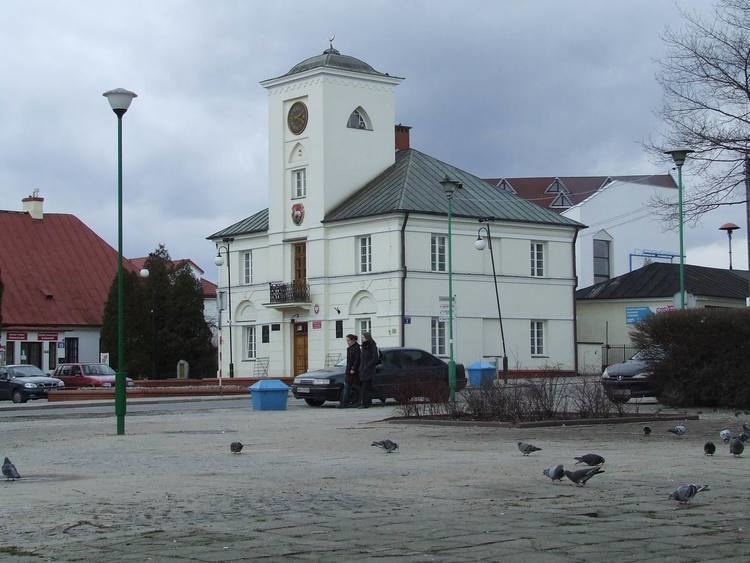Town rights 1429 Area 16.33 km² Local time Friday 9:37 AM | County Piaseczno County Established 14th century Time zone CET (UTC+1) Population 43,540 (2015) | |
 | ||
Weather 14°C, Wind W at 14 km/h, 74% Humidity | ||
Piaseczno [pʲaˈsɛt͡ʂnɔ] is a town in central Poland with 43,540 inhabitants (2015). It is situated in the Masovian Voivodeship, approximately 16 kilometres (10 miles) south of Warsaw. It is a popular residential area and a suburb of Warsaw and is strongly linked to the capital, both economically and culturally. It is the capital of Piaseczno County.
Contents
- Map of Piaseczno Poland
- Early History
- Napoleonic Wars
- World War I
- World War II
- Town Hall
- Religious communities
- Modern Landmarks
- Twin towns Sister cities
- References
Map of Piaseczno, Poland
Early History
The origins of the city dates from a village in the 13th century when it was part of Bohemia, located on the route between Warsaw and Czerskiem. Its strategic position meant that the village grew quickly. On 5 November 1429 the town obtained a charter, and soon became a local market. A further charter was confirmed in 1461.
In 1537 the town became Royal property and in the second half of the 16th century reached 1200 inhabitants based round the brewing and transport industries. However, the city suffered setbacks because of numerous fires in the late 16th and early 17th centuries but returned to its former glory in the first half of the 18th century.
The town church was built in 1736 by architect Carl Frederick Pöppelmann and during the second partition of Poland the city was burned during the Battle of Gołków which took place on 9 and 10 July 1794. Only a church and few houses survived.
Napoleonic Wars
From 1806 to 1807 a French cavalry unit was stationed in the town as part of the Napoleonic wars, and from 1808 to 1811 this was replaced by the Polish 1st Regiment mounted rifles. The Congress of Vienna, saw the area ceded to Russia in 1815.
In 1825 the road from Warsaw and shortly afterward the railway improved links to Warsaw as a result Piaseczno experienced a period of economic recovery.
World War I
In September and October 1914 Piaseczno was the site of fierce fighting between German and Russian Forces in the battle for Warsaw. In May 1917, the new City Council held its first council meeting and in November 1918 German gendarmerie surrendered.
On June 4, 1928, Polish President Ignacy Mościcki laid the cornerstone for the folk house and in 1933 Marshal Józef Piłsudski was made an honorary citizen of the city.
World War II
World War II began for the city on 9 and 10 September 1939, when the Polish 54 light artillery regiment fought a skirmish with a German armored division. The Nazi Occupation ended on January 17, 1945, when 1st Armored Brigade entered the city without a fight.
In 1940, during the Nazi Occupation of Poland, German authorities established a Jewish ghetto in Piaseczno, in order to confine its Jewish population for the purpose of persecution and exploitation. The ghetto was liquidated in January 1941, when all its 2,500 inhabitants were transported in cattle trucks to the Warsaw Ghetto, the largest ghetto in all of Nazi occupied Europe with over 400,000 Jews crammed into an area of 1.3 square miles (3.4 km2). From there, most victims were sent to Treblinka extermination camp.
Town Hall
The original Town Hall was burned down in 1655 by the Swedes during the deluge. The second accidentally burned down in 1730. A third Town Hall was constructed in the middle of the 18th century but was burned down during the Kościuszko Uprising in 1794. In 1815 the Russians began rebuilding it and the current Town hall was built in a classical style between 1823-1824.
Religious communities
For some time the town of Piaseczno had a diverse religious community.
As stated above, the Jewish community was deported to the Warsaw Ghetto in 1940.
Piaseczno was the seat of a Hasidic dynasty founded by Rabbi Kalonymus Kalman Shapiro, currently maintained by his extended family in Israel.
Modern Landmarks
Twin towns — Sister cities
Piaseczno is twinned with:
